How to put a deflector on a chimney with your own hands: step-by-step instruction
To enhance traction, various devices and technical innovations are used. The complexity of the selected option directly affects the price. You must admit that you always want to get good quality equipment at minimal cost.
The most profitable solution is to make a deflector on the chimney with your own hands. The design is extremely simple, and the effectiveness of its use is difficult to overestimate.
We will tell you how the device is arranged and explain the principle of its operation. And also give step-by-step instructions for assembling and installing a simple deflector. We supplemented the above information with visual photographs and video clips demonstrating the nuances of the construction and installation of the ventilation hood.
The content of the article:
What is a deflector?
The device used to increase traction is used universally. The end of the chimney, as a rule, is made out with a cap of a certain shape. Moreover, it is not a simple cap for protection against birds, butterflies, leaves and other representatives of flora and fauna.
This product has a certain structure and acts as a traction enhancer, which positively affects fuel consumption.
The need for a deflector
The deflectors offered on the building materials market have various shapes and sizes. The material from which they are made is also different. It can be plastic, galvanized steel, stainless steel and other alloys. The scope of the device is also very wide.
Varieties of traction amplifiers for installation on chimneys for private and collective use differ in appearance, material of manufacture and cost of the product.
Baffle used for gain traction in ventilation ductschimneys.
Depending on the intended purpose, products for installation on:
- chimneys;
- ventilation ducts;
- sewer ventilation stands;
- piston aircraft engine (in the cooling system);
- other systems.
This device is used for chimneys located on the roofs of both residential buildings and baths, garages and other rooms that are heated by a boiler.
The main thing is that for safety reasons it is not forbidden to install such additional devices on the pipe. Moreover, there is no difference whether it is a collective chimney or an individual one.
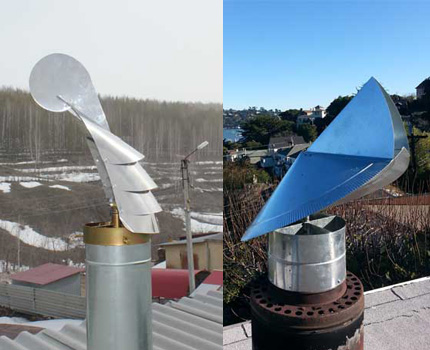
The main functions that a deflector placed on the chimney performs:
- traction reinforcement;
- spark protection;
- preventing the entry of third-party objects and animals into the chimney pipe;
- serves as a substitute for an additional pipe segment;
- protects the inner pipe from destruction.
It turns out that the deflector is a very useful device. The only thing you need to take into account the individual characteristics of the heating boiler installed in the house / bath and the material with which the roof is covered.
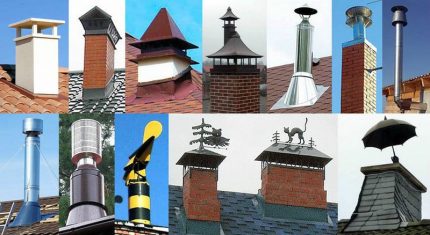
Special installation requirements gas chimney vent. In some models of units, the installation of any devices in the chimney is categorically contraindicated.
How is the reflector arranged?
The deflector in translation means “reflect”, “reject”, which fully characterizes its capabilities. It, depending on the model, may consist of various parts.
The main components of the device:
- lower cylinder;
- top glass;
- cap.
The inlet or lower cylinder is in direct contact with the chimney pipe. It is made of sheet metal. It can also be a pipe made of asbestos-cement or ceramic pipe.
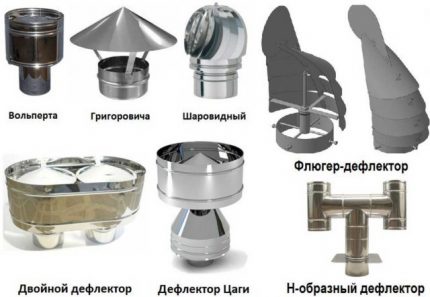
The upper glass expands at the bottom. To attach it to the cylinder, use special racks. On the upper and lower cylinder, circular holes are made to change the direction of the wind.
A cap, umbrella or top is all the name for the top of the diffuser.It can have a different shape - a semicircular, flat, with a lid, gable forceps surface.
The principle of operation of the ventilation hood
The deflector is able to take off from the slightest impact of the wind on it. Moreover, it is not just bent to the side, but also set so as to provide the most favorable conditions for the removal of combustion products through the chimney pipe. The main thing is that the wind does not interfere with this process.
The principle of operation of the deflector is that it is mounted on a pipe that removes smoke and interferes with the free movement of air masses. The wind has to go around this obstacle.
Moreover, enveloping the roof of the device, it accelerates and a vacuum / low pressure zone is created in this place. This allows the draft in the chimney to increase by at least 11-20%.
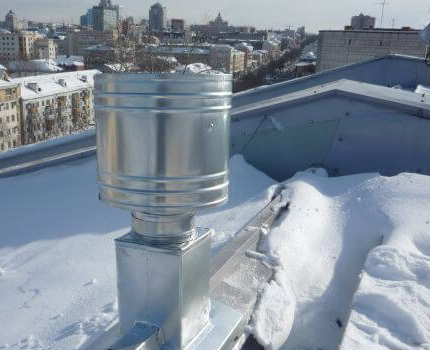
Depending on the type of wind that walks over the roof, air currents can behave differently.
Possible options:
- wind blows down the pipe - in this case, the gases will be drawn in through the lower holes;
- wind blows up and down the deflector - air masses pass through the upper annular openings;
- air masses move horizontally - immediately involved the upper and lower row of holes.
The second option is the most unfavorable wind movement. In this case, the deflector umbrella on the chimney reflects the wind in the direction opposite to the movement of the combustion products.
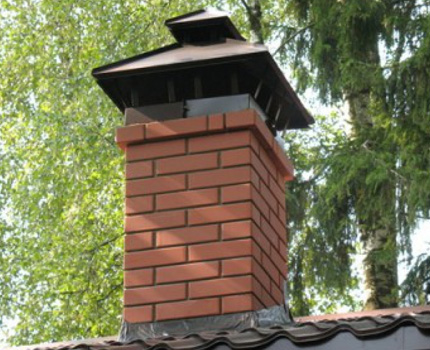
To wrap this situation for their own benefit, they use another cone, which is the same size as the main one. They are interconnected by bases. It turns out that the deflector umbrella consists of 2 cones, the tip of which is directed in opposite directions.
Do it yourself or buy a device?
The question of the appropriateness of buying a baffle worries frugal homeowners. This is not surprising, because the simplest device costs about 17-18 dollars. The average purchase price is $ 45-60.
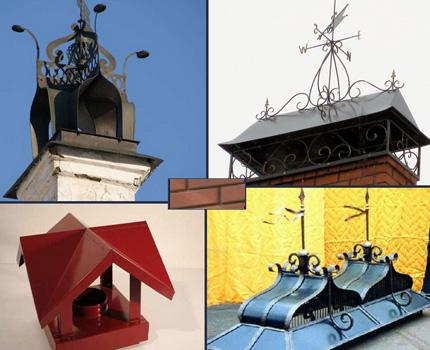
In this case, to make the device is not difficult. And the aesthetic component does not always come first. Sometimes a deflector is needed on the chimney of a boiler heating a garage or other utility room.
The cost of the simplest deflector options starts at $ 17. To buy a model of Khanzhenkov, TsAGI or Volpert-Grigorovich from galvanized steel, you need up to $ 50. Moreover, it can be factory products or made by handicraft.
The efficiency of the device does not depend on the manufacturing method. The main thing here is to choose the right diameter of the product and the right model that can satisfy the needs of a particular chimney.
When buying, you should pay attention to the characteristics of the deflector:
- material type;
- metal thickness;
- diameter of the nozzle for mounting on the chimney pipe.
Manufacturers also offer stainless steel options. They differ in cost - the price of rotary stainless steel models can reach $ 140 or more.
The most common deflectors used for chimneys in private houses, cottages and saunas: TsAGI, round “Volper”, H-shaped, star-shaped “Shenard”, Grigorovich and open Astato.
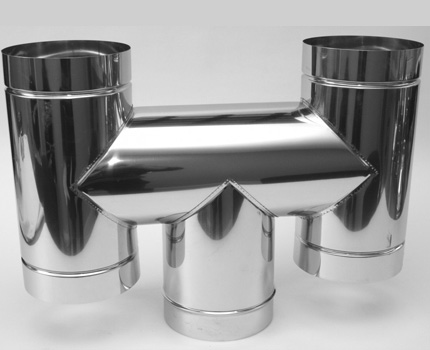
Buy or build a traction amplifier - to be decided individually.For lovers of something to do housework, this task will be a pleasant and interesting activity.
If there are no tools and skills for doing housework, then it will be easier and more convenient to purchase a finished product by choosing the most suitable model that will not get out of the general picture of the roof.
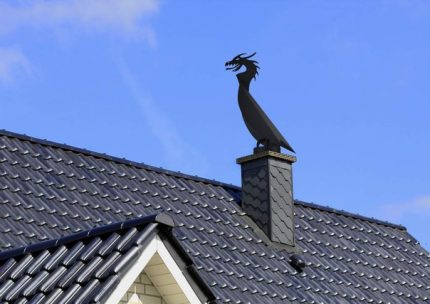
When buying or making a device yourself, it is important to consider the roof covering material. If this is a flammable material, it is imperative to provide for the presence of a spark arrester. This is an important item that ensures safety for all family members living in the house.
Production and installation of the deflector
The deflector is tested in action by more than one generation of owners of houses / cottages. Its effectiveness has been proven repeatedly, so it is not surprising that the device is in demand. And demand, in turn, creates supply.
The price of such offers can sometimes bite - not every prudent owner is ready to give $ 140 for a simple device.
Assembly procedure for the ventilation element
Assembling a deflector from improvised materials will be much cheaper. Especially if you want to build something useful with your own hands. The entire production process of the device will take 2-3 hours - the time depends on the skill and skills of the collector.
The process of manufacturing a reflector that enhances traction, with your own hands, consists of the following steps:
- create a drawing;
- make blanks;
- assemble the device;
- Install and secure it in the chimney.
The first step in creating a drawing is best done on paper. For this, it is important to correctly calculate the diameter of the inlet pipe and the diameter of the cap. And also, the height of the deflector itself.
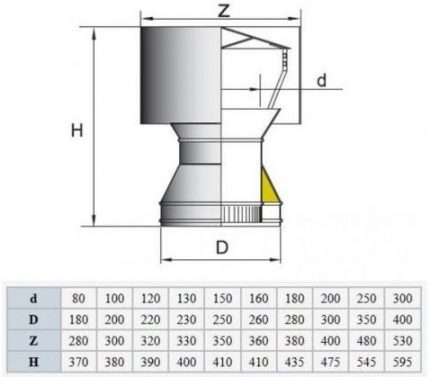
In order not to be mistaken, you can use generally accepted formulas for your calculations.
The main role in the calculations is played by the internal diameter of the chimney pipe:
- height= 1.6-1.7 * diameter;
- diffuser width= 1.2-1.3 * diameter;
- cap width= 1.7-1.9 * diameter.
When there is a formula, it remains to correctly measure the inner diameter of the pipe at the chimney and substitute the obtained value. Knowing the size, you can begin to draw the contours of the blanks on paper.
It is best to create a prototype of the finished paper product after creating the drawing. Thus, possible errors and shortcomings will become clearer. If there are none, then you can proceed to the second stage - the creation of real metal blanks.
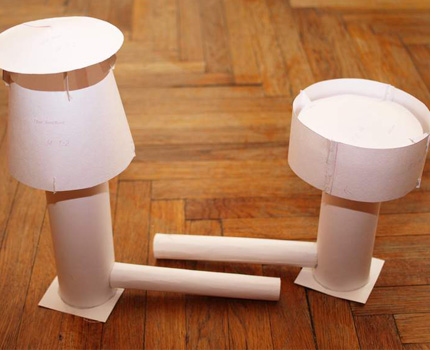
As a material, you can use a sheet of galvanized or stainless steel with a thickness of 0.5-1 mm. Sometimes one may come across the opinion that it is best to use copper for a deflector.
This statement has the right to life if in the garage or workshop accidentally there is an unnecessary sheet of copper. Otherwise, such an expensive purchase will not justify itself. Yes, and the service life of a stainless steel can not be called short to neglect this material.
When the workpieces are cut with scissors for metal from the prepared sheet, you can proceed to the stage of assembly of the product. To do this, you can use a rivet and drill or welding. When working with welding, you need to be extremely careful so as not to accidentally burn a portion of the future deflector.
If you plan to use rivets, then allowances for connecting parts to each other are conveniently done on a rolling machine. If this is not the case, then the hammer will fit perfectly. Having made allowances, it is necessary to smoothly connect the parts together, make holes with a drill and put rivets.
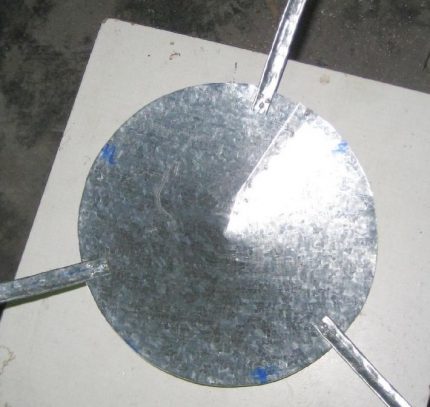
The cap is to be fixed to the base with legs, which are also drawn and cut out of stainless steel / galvanized sheet.
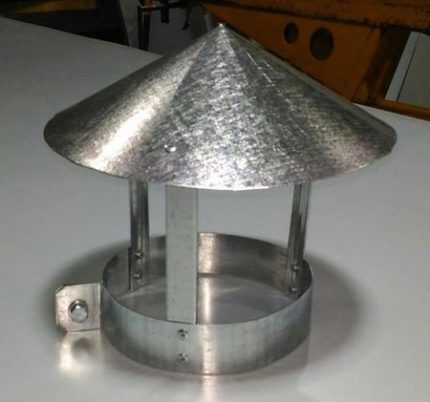
When the 3rd stage is over and the homemade product is ready, you can proceed to the last and most crucial moment - installation in the chimney.
Roof vent installation
The last stage in the manufacture of the deflector on the chimney pipe is to install it on the place of permanent location - on the chimney. You can put it on your own as a home-made device, or a purchased design. There is no difference - you still have to climb onto the roof.
In order not to have problems with installation, even a purchased model, which is disassembled, must be assembled at the bottom, securely fixing all the fasteners. Only then can you take the necessary tool and go to the chimney.
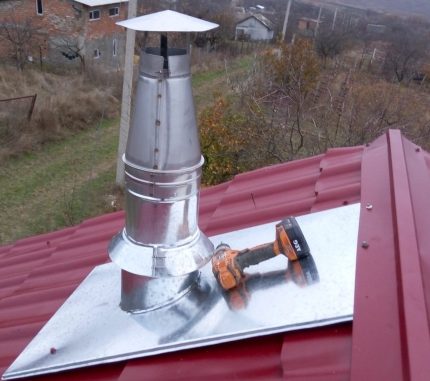
When installing the deflector on the chimney pipe, carefully drill the mounting holes. Then it remains to securely fasten the screws or rivets and check whether the installed device tilts in different directions.
If he hangs, then you can additionally put a clamp. This option is suitable if the chimney is not faced with brick.
For brickwork with a square or rectangular section of the chimney, you will have to use special adapters. When the work is completed, you can test the deflector installed by yourself, by flooding the stove / turning on the heating boiler.
Another important point is the spark arrester. Whether he needs it or not - they look in a particular house. Can make a spark arrester yourself from stainless steel sheet or metal mesh.

Errors and problems with the device
With the deflector, as with all devices, troubles can arise. One, the largest and most preventable, is incorrect work. This happens if the device was matched to the wrong size. It can simply fall into the chimney pipe, blocking the path for the exit of combustion products.
To avoid this situation, you need to pay attention that the diameter of the pipe of the deflector must be equal to the diameter of the inner chimney pipe.
If the chimney is brick, and the device to be installed has a circular cross section, then you can not do without the corresponding adapters.
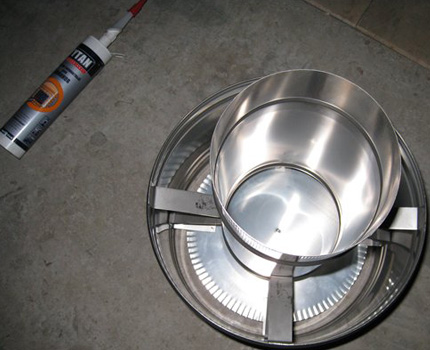
The second mistake when installing the deflector is the choice of a rotating model for areas with cold and snowy winters.Such a solution is fraught with icing up of the device, and in a few days it will be covered with snow and not only stop rotating, but will also significantly interfere with the normal operation of the chimney.
To clear everything by removing snow and ice, you have to climb the roof, and this is not the most pleasant thing on a cold and snowy day.
The third nuisance is the inefficiency of the deflector.
A problem may arise if the installation location or model is incorrectly selected:
- the body of the device is poorly blown by winds of various directions;
- in an area with gusty winds, an H-shaped deflector will be more effective;
- Avoid installing the device in the area of the aerodynamic shadow of trees and higher structures located nearby;
- the appliance must be located above the roof ridge and above other structures, if present near the chimney.
If the deflector was ineffective, then you need to look reasons for backdraft chimney.
The fourth problem is the breakdown of rotating models. The fact is that the mechanisms that provide rotation require care. More precisely, one must not forget to periodically conduct maintenance of individual parts of the deflector, lubricate the bearings on time.
If the device was made with your own hands, and the material used in this case turned out to be cheap and of poor quality, then everything can rust very quickly. In this case, you will soon have to replace it with a new deflector.
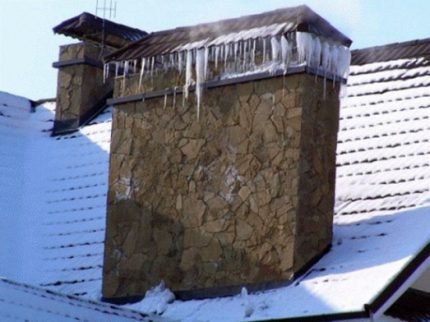
Another problem is when a simple hood is installed instead of the deflector. It can freeze and snow over it. This will have to be eliminated. It is dangerous if such a situation occurs at night and all combustion products remain in the house. This is fatal for all households.
Therefore, you need to immediately put the deflector and not experiment with various visors-caps. If there is no desire to build an amplifier from improvised materials, you can always buy your favorite model and install it yourself on the chimney.
It is necessary to take care of the normal operation of the boiler and the efficient removal of combustion products at the heating design stage. Useful information on the construction of the chimney is presented in this article.
Conclusions and useful video on the topic
How a deflector capable of extinguishing sparks is arranged is described in the video clip:
The step-by-step production of the TsAGI deflector in-house without special equipment is shown in the video:
Calculation, manufacture and verification in action of a self-made deflector are given in the video clip:
A detailed video about the manufacture of a deflector for a chimney with explanations and a visual statement of each action:
Having studied in more detail the issue of assembling and installing the deflector, you can use your own forces to protect your chimney from unwanted interference in its operation of the wind and various kinds of rain and debris. Also, this simple device will help to significantly increase traction.
Do you have personal experience building a chimney deflector? Want to share practical skills or ask questions on a topic? Please leave comments - the feedback form is located below.

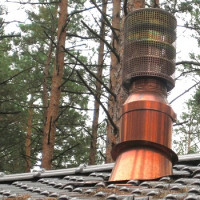 How to make a spark arrestor on a chimney with your own hands: a step-by-step guide
How to make a spark arrestor on a chimney with your own hands: a step-by-step guide 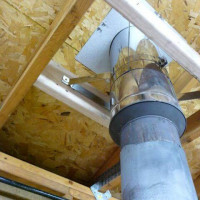 How to make the right chimney for a do-it-yourself stove: a step-by-step instruction
How to make the right chimney for a do-it-yourself stove: a step-by-step instruction  Gas boiler chimney deflector: installation requirements and installation rules
Gas boiler chimney deflector: installation requirements and installation rules 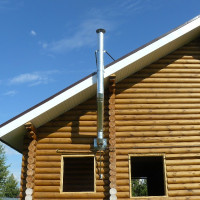 How to make a chimney in a private house with your own hands: design options and their implementation
How to make a chimney in a private house with your own hands: design options and their implementation  How to make a gate for a chimney with your own hands: instructions for making a valve
How to make a gate for a chimney with your own hands: instructions for making a valve 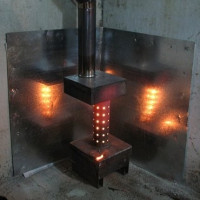 Do-it-yourself garage oven: a step-by-step guide to design
Do-it-yourself garage oven: a step-by-step guide to design  How much does it cost to connect gas to a private house: the price of organizing gas supply
How much does it cost to connect gas to a private house: the price of organizing gas supply  The best washing machines with dryer: model rating and customer tips
The best washing machines with dryer: model rating and customer tips  What is the color temperature of light and the nuances of choosing the temperature of the lamps to suit your needs
What is the color temperature of light and the nuances of choosing the temperature of the lamps to suit your needs  Replacement of a geyser in an apartment: replacement paperwork + basic norms and requirements
Replacement of a geyser in an apartment: replacement paperwork + basic norms and requirements
They made a major overhaul of the roof in the country, threw out the old rusty deflector - I thought it would do! But it turned out that no! When a pigeon flew into the chimney and couldn’t get out, I realized that I was stupid. In short, we got a bird, put a new deflector (I didn’t buy it - I made it myself out of stainless steel). After that, I noticed that traction also got better. So the deflector is a must in the chimney!
And what do we have in bucks - dollars for iron-deflectors?
I do not see anything surprising in this, especially considering that the site has many visitors from different CIS countries. Therefore, it is more practical to indicate the price tag of sales, parts, components and other things in dollars. Personally, I always do this, plus the economic situation can change, in which case the price tag in dollars will practically not need to be adjusted.
I can share examples of my work, which were made to order. I can say that the price of such a product relative to 2017 (only 2 years passed) increased by 20%. And not because I began to raise the price tag higher, but the cost of materials has become trite, while almost nothing has changed in the dollar equivalent. In general, if you consider that all transport delivery is tied to gasoline, which is tied to the dollar, then indicating the price of products and accessories on the forum in this currency is the right decision.